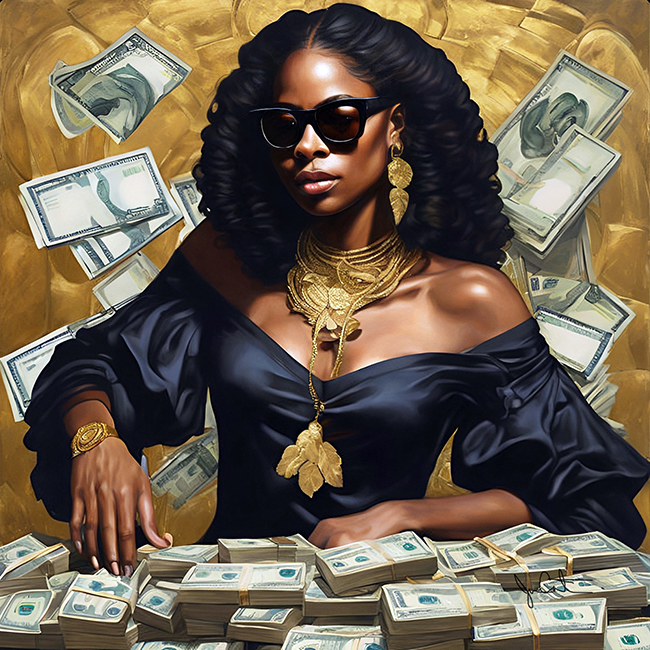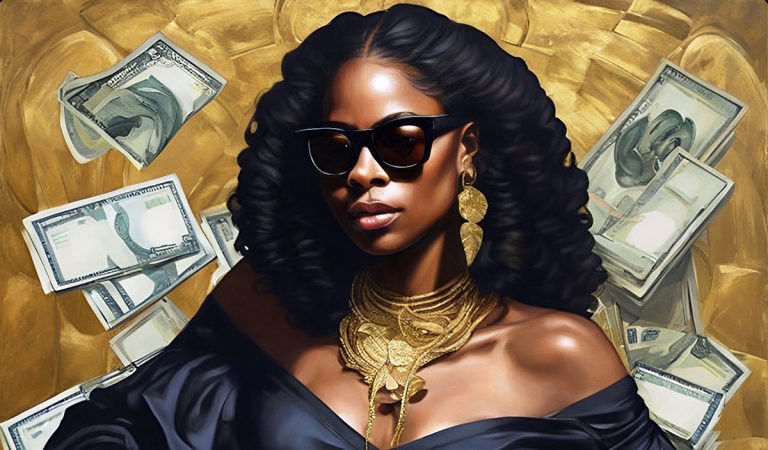In the realm of contemporary art, Jarron Carter is an artist who offers viewers a journey that challenges, captivates, and resonates on a deeply emotional level. With a unique blend of precision, elegance, and an unmistakable touch of opulence, Carter’s artworks are more than mere visuals; they are narratives that invite viewers to explore the depths of their own emotions and perspectives.

What sets Carter apart is his ability to infuse his art with profound emotional depth. “With the accuracy of my lines and poses in motion, I make the viewer really feel the emotional mood my art creates,” he shares. This emotional resonance is no accident. It stems from Carter’s own personal experiences, emotions, and even his obsessions with foreign cultures and history. Each piece he creates is a window into his world, offering glimpses of his personality, dreams, and fantasies.
Carter’s latest work, titled “Trap Queen,” exemplifies his skill for blending personal experiences with a broader commentary on society. This mixed-media digital piece is a powerful depiction of a successful Black woman who, against all odds, has climbed her way from the bottom to the top. The title itself—”Trap Queen”—is layered with meaning, reflecting both the artist’s journey and the complex reality of many individuals who rise from challenging circumstances.
For Carter, growing up in poverty often felt like a trap from which escape seemed impossible. This piece reflects that sentiment while also serving as a beacon of hope. “Many have made it out of that trap and became successful,” Carter says. The piece is a tribute to those who have defied the odds, a reminder that with belief in oneself and hard work, success is attainable. However, Carter’s art is never one-dimensional. He deliberately leaves room for interpretation, allowing viewers to find their own meanings and emotions within the work.
“Trap Queen” is also a commentary on materialism and the darker aspects of ambition. While it celebrates success and the power of self-determination, it also poses questions about the cost of such achievements. The central figure in the piece can be seen as someone who has achieved material success but at what expense? Is she someone who values money above all else, or is there more beneath the surface? Carter’s use of digital media allows him to play with contrasts and textures, highlighting the duality of success and the potential pitfalls of a materialistic mindset.
The visual composition of “Trap Queen” is striking. Carter employs a rich, opulent color palette that draws the viewer in, with intricate details that reveal more upon closer inspection. The figure at the center is both powerful and enigmatic, her pose suggesting confidence and control, yet there is an underlying tension that hints at the struggles she has faced. The background is layered with symbols of wealth and luxury, yet there are also elements that suggest confinement or entrapment—a nod to Carter’s own feelings of being trapped by poverty in his youth.
This duality is a recurring theme in Carter’s work. He is not content to simply celebrate success; he also explores its darker sides, the sacrifices made, and the potential for loss of self in the pursuit of wealth. “Trap Queen” is a piece that can be seen as both inspirational and cautionary, depending on the viewer’s perspective. It challenges the viewer to consider their own relationship with success and material wealth and to reflect on what truly matters in life.
In many ways, “Trap Queen” is a culmination of Carter’s artistic journey. It embodies his commitment to creating art that is emotionally resonant. Through his precise lines and dynamic compositions, Carter invites viewers to engage with his work on a deeper level, to see beyond the surface and into the emotions and experiences that drive his creations. “Trap Queen” is more than just a piece of art; it is a narrative, a reflection, and a challenge—all wrapped in a visually captivating package.
“Trap Queen” is a testament to his commitment to exploring the complexities of the human experience through his art. Whether seen as a celebration of success, a critique of materialism, or a reflection of the artist’s own journey.

